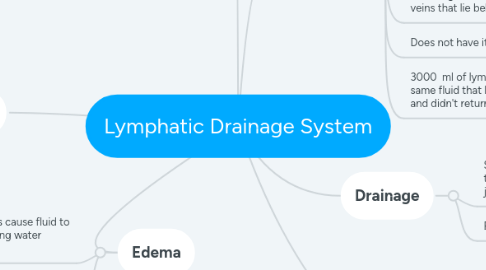Lymphatic Drainage System
by The Kaiiraa


1. Lymphatic Capillaries
1.1. Admit large amounts of tissue fluid
1.2. contains debris too large to enter the blood capillaries which could cause a problem if it got into the blood
1.2.1. Protein
1.2.2. Pus
1.2.3. Damaged or dead cells
1.2.4. Bacteria/pathogens
1.2.5. Cancerous cells
2. Fat digestion
2.1. LS important role in FD
2.2. Nutrients absorbed by small intestine enter the bloodstream
2.3. Fat-soluble vitamins A, D, E, and K is taken into the lymph first
3. Edema
3.1. Zero healthy lymph vessels cause fluid to build up in the tissue causing water retention
3.2. Body can regrow lymph capillaries
4. Function
4.1. Cleans the body by draining excess fluids and debris from the tissues
4.2. Cleans up internal and external threats to health from the immune system
4.3. Two distinctive systems
4.3.1. drainage aspect of the LS is a priority, but the immune function is a complex process involving many body systems.
